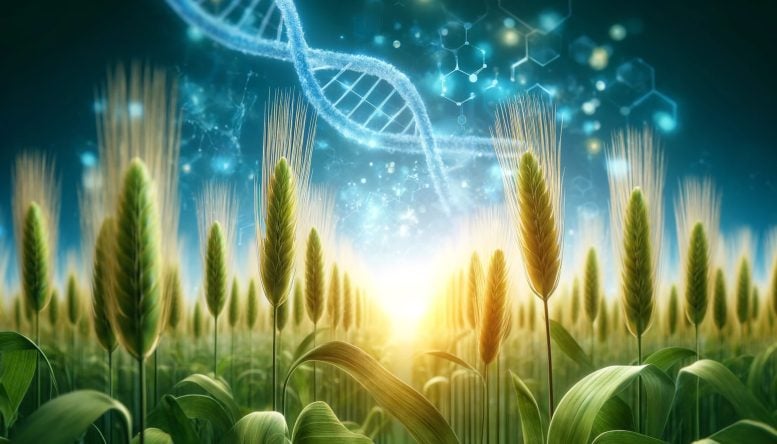
During a 23-year study at the University of Bonn, researchers found that organically grown barley genetically adapted to its environment, becoming more genetically diverse and robust than barley grown conventionally. The study highlights the need to develop crop varieties specifically for organic farming to exploit these adaptive advantages. Credit: SciTechDaily.com
A research project carried out at the University of Bonn reveals differences in plant growth using organic and conventional farming methods.
A long-term study conducted at the University of Bonn has shown that plants can genetically adapt to the specific conditions of organic farming. As part of the study, researchers grew barley on two adjacent fields, using conventional farming techniques on one and organic practices on the other.
For more than 20 years, organic barley has been enriched with specific genetic material, different from the comparative crop. The results demonstrate, among other things, how important it is to cultivate varieties, particularly for organic farming. The results have now been published in the journal Agronomy for sustainable development.
At the end of the 1990s, Professor Jens Léon launched an experiment at the University of Bonn that he knew would last a long time. His research group wanted to study the effects of agricultural conditions on plant genetic material. To do this, they carried out a complex long-term study over a period of 23 years at the Institute of Crop Sciences and Resource Conservation (INRES). “We first crossed high-yielding barley with a wild form to increase genetic variation,” explains Léon. “We then planted these populations on two neighboring fields so that the barley grew in the same soil and under the same climatic conditions. »

The image above shows the conventional population on the left and the organic barley on the right: only experts can spot the differences with the naked eye. However, huge differences can be identified using molecular genetics. Credit: AG Prof. Léon/University of Bonn
The only difference was the farming method. Conventional agriculture was used in one of the areas where researchers used pesticides to control pests, chemical agents to eliminate weeds and mineral fertilizers to ensure a good supply of nutrients. In the other area, researchers adopted a more ecological approach: no pesticides, weed control using mechanical methods and soil fertilization with manure from the stables.
A portion of the grain was saved each fall for sowing in the fields the following spring – using organic grain from the organic field and barley grown under conventional conditions on the comparative field. “However, we did not choose the grains based on particular characteristics, but simply selected a small part of the harvest at random,” emphasizes Dr. Michael Schneider, Léon’s colleague.
Analyzing genome development in time-lapse
The researchers also analyzed the genomes of conventionally and organically grown plants each year. Each gene can exist in different forms called alleles. For example, the human gene responsible for eye color exists in the “brown” and “blue” alleles. The frequency with which certain alleles appear in a population can change over generations. Environmental conditions are a factor that plays a role in this process: the alleles that ensure the development of plants in their current environment are generally found more and more frequently.
The researchers identified two interesting trends in their genetic testing: Over the first twelve years, allele frequencies in barley changed similarly in both fields. “Our interpretation of this finding is that the highly diverse populations caused by crossing with wild barley have adapted to local conditions,” explains Dr. Agim Ballvora, who also participated in the study.
“After all, factors such as climate, soil and especially day length were identical for both populations.” However, the allele frequencies of the two crops increasingly diverged in subsequent years. In particular, barley grown using organic farming methods has developed genetic variants less sensitive to nutrient deficit or lack of water, i.e. alleles that influence root structure. “One of the reasons for this is probably the large variations in nutrient availability in organic farming,” explains Léon.
Genetic heterogeneity facilitates the adaptation process
Conventionally grown barley has also become more genetically uniform over time, meaning that the genetic material of individual plants grown in the field has become more and more similar from year to year. Organic barley, however, remains more heterogeneous. Allele frequencies in the organic crop also varied more widely over time. This resulted in some years being extremely favorable or unfavorable for certain alleles.
This could be because environmental conditions fluctuate much more in organic farming than with conventional management methods: if certain plant diseases take hold over the course of a year, for example, the plants will be more dependent alleles that will protect them. Variability in environmental forces acting on plants appears to lead to greater genetic heterogeneity. “Plants are thus better able to adapt to these kinds of changes,” explains Léon.
Overall, the results demonstrate the importance of growing varieties optimized for organic farming. As their genetic makeup has adapted to these conditions, they will be hardier and provide higher yields. “In addition, it seems wise, when cultivating plants, to cross them with older, or even wild, varieties,” explains Léon. “Our data also indicates that this could even benefit conventional high-yielding varieties. »
Reference: “In-depth genotyping reveals specific adaptation footprints of conventional and organic agriculture in barley populations — an evolutionary approach to plant breeding” by Michael Schneider, Agim Ballvora and Jens Léon, May 8, 2024, Agronomy for sustainable development.
DOI: 10.1007/s13593-024-00962-8
The study was funded by the German Research Foundation (DFG).